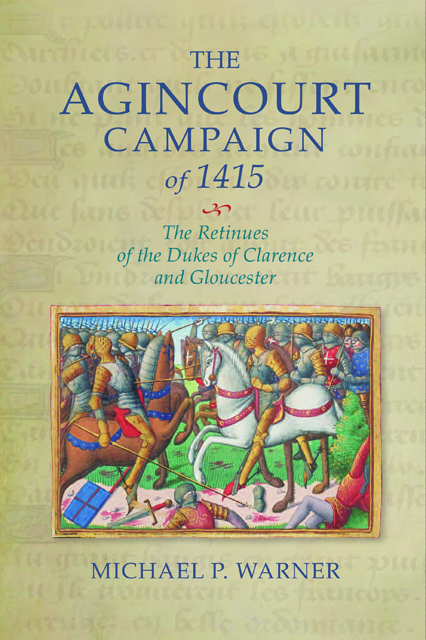Book contents
- Frontmatter
- Contents
- Lists of Tables and Charts
- List of Figures
- Acknowledgements
- Abbreviations
- Introduction
- 1 Before the Campaign
- 2 The Muster Rolls of the 1415 Expedition
- 3 Clarence’s and Gloucester’s 1415 Retinues
- 4 The Sub-Retinue Captains
- 5 During the Campaign
- 6 After the Campaign
- Conclusion
- Appendices
- Bibliography
- Index
- Warfare in History
5 - During the Campaign
Published online by Cambridge University Press: 14 January 2023
- Frontmatter
- Contents
- Lists of Tables and Charts
- List of Figures
- Acknowledgements
- Abbreviations
- Introduction
- 1 Before the Campaign
- 2 The Muster Rolls of the 1415 Expedition
- 3 Clarence’s and Gloucester’s 1415 Retinues
- 4 The Sub-Retinue Captains
- 5 During the Campaign
- 6 After the Campaign
- Conclusion
- Appendices
- Bibliography
- Index
- Warfare in History
Summary
The Siege of Harfleur
Following the successful and relatively uneventful disembarkation of his troops and equipment near Sainte-Adresse from Wednesday, 14 August until Saturday, 17 August, King Henry, as the eyewitness author of the Gesta Henrici Quinti informs us, formed his army into three ‘battles’ – three divisions. The first was placed under the command of Clarence, and included the duke of York’s retinue. It was ordered to lay siege to Harfleur from the eastern side. Gloucester and his retinue were based with the king to the west of the city. According to Tito Livio Frulovisi, whose patron was Gloucester and who wrote his account of the siege in his work Vita Henrici Quinti around 1438, Gloucester was granted command of part of the army. Which specific section of the army he commanded is not entirely clear. He was certainly not in the east with Clarence. It is possible he oversaw the wooden bastion built by English carpenters opposite the French redoubt at Porte-de-Leure, near Harfleur’s western gate. Yet, this is again questionable because he is not detailed by John Hardyng as one of the captains assigned to this position. Hardyng claimed to have been present on the campaign, but historians have questioned his assertion. As such, the veracity of Hardyng’s account is dubious and to rely on it would be a mistake. Another very plausible possibility is that the duke commanded the section of the army positioned slightly southwards of the king’s main camp at Mont-le-Comte, near to Porte-de-Leure.
As Clarence and his men marched to their position, they found their way blocked by a lake formed by the defenders of Harfleur in an attempt to hinder the English by closing the town’s northern sluice gates on the Lézarde river. Clarence’s force had to undertake a 16 kilometre circuitous detour, not arriving at the eastern side of the town until Monday, 19 August, by which time the French knight Raoul de Gaucourt had managed to rush 300 men-at-arms into Harfleur to bolster its garrison. The detour itself was not without incident. As the duke and his men passed the town of Montivilliers, the garrison sallied forth and attacked the division.
- Type
- Chapter
- Information
- The Agincourt Campaign of 1415The Retinues of the Dukes of Clarence and Gloucester, pp. 133 - 155Publisher: Boydell & BrewerPrint publication year: 2021

